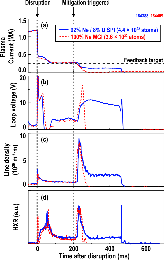Dissipation of post-disruption runaway electron plateaus by shattered pellet injection in DIII-D
- Oak Ridge National Lab. (ORNL), Oak Ridge, TN (United States)
- Oak Ridge Associated Univ., Oak Ridge, TN (United States); Lawrence Livermore National Lab. (LLNL), Livermore, CA (United States)
- General Atomics, San Diego, CA (United States)
- Univ. of California, San Diego, CA (United States)
Here, we report on the first demonstration of dissipation of fully avalanched post-disruption runaway electron (RE) beams by shattered pellet injection in the DIII-D tokamak. Variation of the injected species shows that dissipation depends strongly on the species mixture, while comparisons with massive gas injection do not show a significant difference between dissipation by pellets or by gas, suggesting that the shattered pellet is rapidly ablated by the relativistic electrons before significant radial penetration into the runaway beam can occur. Pure or dominantly neon injection increases the RE current dissipation through pitch-angle scattering due to collisions with impurity ions. Deuterium injection is observed to have the opposite effect from neon, causing the background thermal plasma to completely recombine, reducing the high-Z impurity content and thus decreasing the dissipation. When injecting mixtures of the two species, deuterium levels as low as ~10% of the total injected atoms are observed to adversely affect the resulting dissipation, suggesting that complete elimination of deuterium from the injection may be important for optimizing RE mitigation schemes.
- Research Organization:
- Lawrence Livermore National Lab. (LLNL), Livermore, CA (United States); Oak Ridge National Lab. (ORNL), Oak Ridge, TN (United States)
- Sponsoring Organization:
- USDOE Office of Science (SC), Fusion Energy Sciences (FES)
- Grant/Contract Number:
- FC02-04ER54698; AC05-00OR22725; AC05-060R23100; FG02-07ER54917
- OSTI ID:
- 1432365
- Journal Information:
- Nuclear Fusion, Vol. 58, Issue 5; ISSN 0029-5515
- Publisher:
- IOP ScienceCopyright Statement
- Country of Publication:
- United States
- Language:
- English
Web of Science
Similar Records
Density and temperature profiles after low-Z and high-Z shattered pellet injections on DIII-D
Injection of multiple shattered pellets for disruption mitigation in DIII-D







